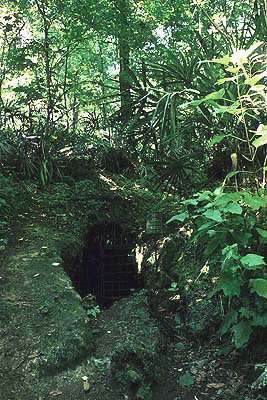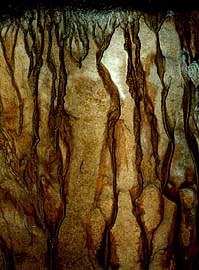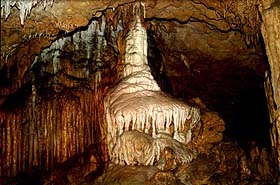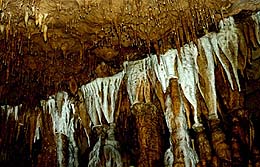Florida Caves
 These caves are home to the Gray Bat (Myotis grisescens), an
endangered species. The bats are not tolerant of disturbance,
and during the winter, when they are hibernating and trying to
preserve their energy reserves, being awakened can have fatal
consequences for many of them.The bars do not impede their access
to and from the cave, but keep humans out. The sign informs you
of the dire penalties which will befall you should you be caught
trying to break in.
These caves are home to the Gray Bat (Myotis grisescens), an
endangered species. The bats are not tolerant of disturbance,
and during the winter, when they are hibernating and trying to
preserve their energy reserves, being awakened can have fatal
consequences for many of them.The bars do not impede their access
to and from the cave, but keep humans out. The sign informs you
of the dire penalties which will befall you should you be caught
trying to break in.
The soil of the upland forest at Florida Caverns State Park is
only a few feet (in places, only a few inches) thick, and the
root systems of even the largest trees do not extend very deep.
This White Oak was the victim of one of 1995's tropical storms.
When it went over, it took the topsoil with it, leaving bare the
limestone bedrock.
Equal in beauty to such famous sites as Mammoth Cave and Carlsbad
Caverns, the caves at Florida Caverns State Park contain dazzling
formation of stalactites, s talagmites, soda straws, columns,
rimstones, flowstones and draperies.
 These fragile formations are composed of calcite, a mineral
dissolved from limestone rock when surface water containing
carbonic acid percolates through the rock into the caves. As this
mineral-charged water encounters the air inside the caves, layers
of calcite are deposited. The creation of these stunning formations
often take tens of thousands of years, and even the slightest
disturbance by humans can destroy these delicate natural wonders.
People also may adversely affect a variety of animals that visit
or dwell within the caves. The endangered gray bat, found in some
caves, is easily disturbed by human voices or lights. If awakened
during the winter months, hibernating bats expend valuable energy
which they otherwise need to survive. Caves inhabited by gray bats
receive special legal protection under the federal Endangered
Species Act of 1973.
These fragile formations are composed of calcite, a mineral
dissolved from limestone rock when surface water containing
carbonic acid percolates through the rock into the caves. As this
mineral-charged water encounters the air inside the caves, layers
of calcite are deposited. The creation of these stunning formations
often take tens of thousands of years, and even the slightest
disturbance by humans can destroy these delicate natural wonders.
People also may adversely affect a variety of animals that visit
or dwell within the caves. The endangered gray bat, found in some
caves, is easily disturbed by human voices or lights. If awakened
during the winter months, hibernating bats expend valuable energy
which they otherwise need to survive. Caves inhabited by gray bats
receive special legal protection under the federal Endangered
Species Act of 1973.
 Florida Cavern is the only developed "tour cave" in the park.
Florida Park Service permits are required to enter all other caves
in the park. Some of the caves which require permits for entry
are open for scientific research only. For the protection of the
unique and sensitive resources which are found in these caves,
visitors are asked to respect the off-limits status of these
caves.
Florida Cavern is the only developed "tour cave" in the park.
Florida Park Service permits are required to enter all other caves
in the park. Some of the caves which require permits for entry
are open for scientific research only. For the protection of the
unique and sensitive resources which are found in these caves,
visitors are asked to respect the off-limits status of these
caves.
Although the caverns are the focal point of the park, the
1,280-acre grounds also boast a wide variety of plants, animals
and other natural resources. American beech, Southern Magnolia,
white oak and dogwood trees are prominent throughout the park,
along with a number of plants that are also found in the southern
Appalachian Mountains of north Georgia.
 Woodpeckers, barred owls, beavers, alligators, rare Barbour's
map turtles and alligator snapping turtles also inhabit the area.
The pristine Chipola River flows underground in the park at the
river sink and reappears several hundred feet downstream, thereby
forming a natural bridge. In the early 1900s, loggers cut a ditch
across this natural bridge to float logs downstream.
Woodpeckers, barred owls, beavers, alligators, rare Barbour's
map turtles and alligator snapping turtles also inhabit the area.
The pristine Chipola River flows underground in the park at the
river sink and reappears several hundred feet downstream, thereby
forming a natural bridge. In the early 1900s, loggers cut a ditch
across this natural bridge to float logs downstream.
Kick n' Back |Navy Links | Misc. Links | Civil War Links | Personal Info | Florida | Early Origins | Special Place | La Florida
This page hosted byGeoCities.
Get your own Free Home Page
Site© 1996-2004
 These caves are home to the Gray Bat (Myotis grisescens), an
endangered species. The bats are not tolerant of disturbance,
and during the winter, when they are hibernating and trying to
preserve their energy reserves, being awakened can have fatal
consequences for many of them.The bars do not impede their access
to and from the cave, but keep humans out. The sign informs you
of the dire penalties which will befall you should you be caught
trying to break in.
These caves are home to the Gray Bat (Myotis grisescens), an
endangered species. The bats are not tolerant of disturbance,
and during the winter, when they are hibernating and trying to
preserve their energy reserves, being awakened can have fatal
consequences for many of them.The bars do not impede their access
to and from the cave, but keep humans out. The sign informs you
of the dire penalties which will befall you should you be caught
trying to break in.
 These fragile formations are composed of calcite, a mineral
dissolved from limestone rock when surface water containing
carbonic acid percolates through the rock into the caves. As this
mineral-charged water encounters the air inside the caves, layers
of calcite are deposited. The creation of these stunning formations
often take tens of thousands of years, and even the slightest
disturbance by humans can destroy these delicate natural wonders.
People also may adversely affect a variety of animals that visit
or dwell within the caves. The endangered gray bat, found in some
caves, is easily disturbed by human voices or lights. If awakened
during the winter months, hibernating bats expend valuable energy
which they otherwise need to survive. Caves inhabited by gray bats
receive special legal protection under the federal Endangered
Species Act of 1973.
These fragile formations are composed of calcite, a mineral
dissolved from limestone rock when surface water containing
carbonic acid percolates through the rock into the caves. As this
mineral-charged water encounters the air inside the caves, layers
of calcite are deposited. The creation of these stunning formations
often take tens of thousands of years, and even the slightest
disturbance by humans can destroy these delicate natural wonders.
People also may adversely affect a variety of animals that visit
or dwell within the caves. The endangered gray bat, found in some
caves, is easily disturbed by human voices or lights. If awakened
during the winter months, hibernating bats expend valuable energy
which they otherwise need to survive. Caves inhabited by gray bats
receive special legal protection under the federal Endangered
Species Act of 1973.
 Florida Cavern is the only developed "tour cave" in the park.
Florida Park Service permits are required to enter all other caves
in the park. Some of the caves which require permits for entry
are open for scientific research only. For the protection of the
unique and sensitive resources which are found in these caves,
visitors are asked to respect the off-limits status of these
caves.
Florida Cavern is the only developed "tour cave" in the park.
Florida Park Service permits are required to enter all other caves
in the park. Some of the caves which require permits for entry
are open for scientific research only. For the protection of the
unique and sensitive resources which are found in these caves,
visitors are asked to respect the off-limits status of these
caves.
 Woodpeckers, barred owls, beavers, alligators, rare Barbour's
map turtles and alligator snapping turtles also inhabit the area.
The pristine Chipola River flows underground in the park at the
river sink and reappears several hundred feet downstream, thereby
forming a natural bridge. In the early 1900s, loggers cut a ditch
across this natural bridge to float logs downstream.
Woodpeckers, barred owls, beavers, alligators, rare Barbour's
map turtles and alligator snapping turtles also inhabit the area.
The pristine Chipola River flows underground in the park at the
river sink and reappears several hundred feet downstream, thereby
forming a natural bridge. In the early 1900s, loggers cut a ditch
across this natural bridge to float logs downstream.